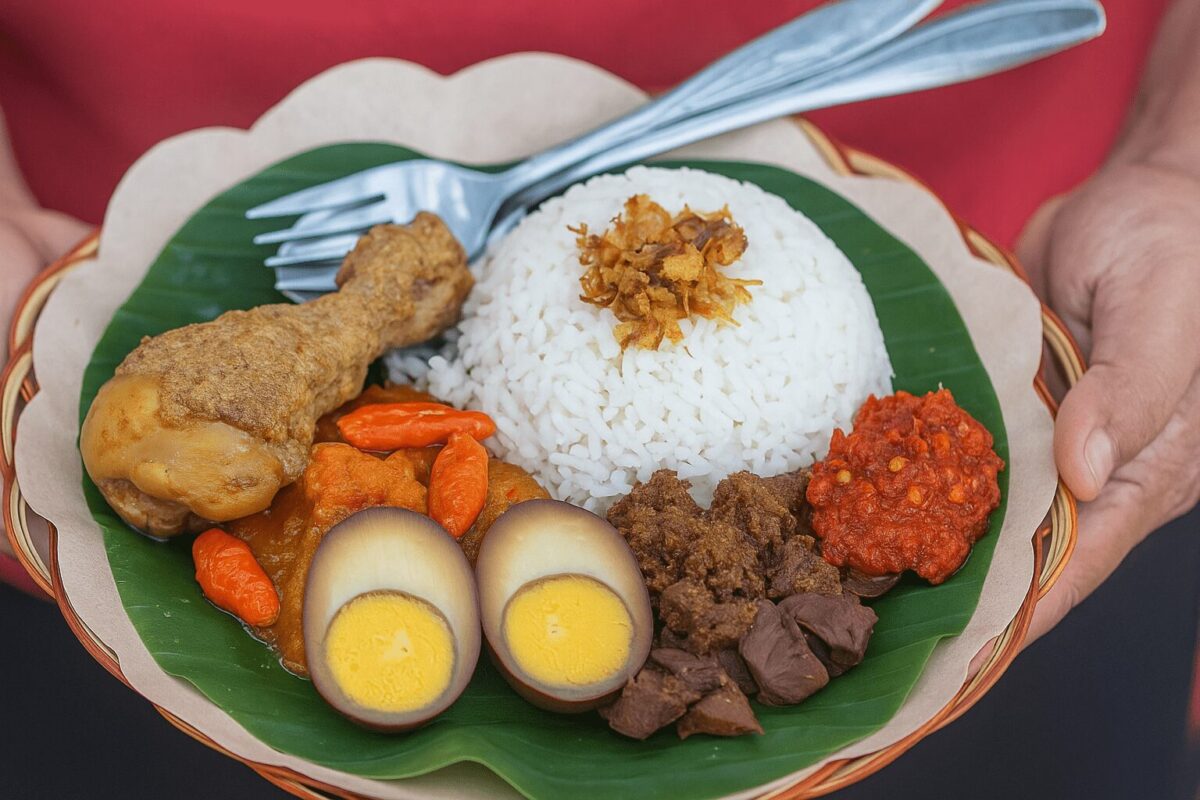The Soul of Yogyakarta on a Plate
In the heart of Java, Yogyakarta thrives not only as a city of art and culture but also as a haven of culinary marvels. Among its most treasured dishes stands Gudeg — a symphony of sweetness, patience, and tradition served in a humble bowl. This dish is not merely food; it is a story of Yogyakarta itself, a slow-cooked embodiment of the city’s grace and resilience.
The Origins of Gudeg: A Taste Born from History
Gudeg traces its lineage back to the 16th century, during the establishment of the Mataram Kingdom. In the fertile lands surrounding Yogyakarta, jackfruit trees grew abundantly. Resourceful palace cooks transformed the young fruit into a nourishing meal that could feed large numbers of workers. Over centuries, Gudeg evolved into a refined culinary art form, deeply entwined with the history of Java’s royal courts.
From Palace Kitchens to Street Stalls: Gudeg’s Journey Through Time
Once reserved for noble tables, Gudeg eventually found its way to the bustling streets of Yogyakarta. The dish’s royal heritage became democratized, served from earthen pots in small roadside stalls and traditional markets. Today, whether savored under the ornate ceilings of heritage restaurants or beside the hum of motorbikes on Malioboro Street, Gudeg retains its same humble essence.
The Essence of Jackfruit: The Heart of Gudeg’s Flavor
At the core of Gudeg lies nangka muda—young jackfruit, tender yet firm, capable of absorbing complex flavors. When simmered for hours in coconut milk and palm sugar, it transforms into a texture both delicate and fibrous, reminiscent of pulled meat. Its subtle sweetness forms the foundation upon which every other ingredient harmonizes.
Sweetness and Tradition: Why Gudeg Is Unlike Any Other Dish in Indonesia
Indonesia is a mosaic of flavors — fiery, sour, and savory — yet Gudeg stands apart with its signature sweetness. This characteristic sweetness is not accidental; it reflects the Javanese philosophy of balance and serenity. Gudeg whispers where other dishes shout, embodying harmony and calmness in every spoonful.
Yogyakarta’s Culinary Identity: How Gudeg Defines the City’s Culture
To speak of Yogyakarta without mentioning Gudeg would be unthinkable. The dish encapsulates the city’s spirit — patient, warm, and profoundly artistic. Just as batik patterns tell stories through color and line, Gudeg narrates its tale through aroma and taste, becoming an edible emblem of Yogyakarta’s soul.
Two Faces of Gudeg: Dry vs. Wet Varieties
Gudeg exists in two prominent forms: Gudeg kering (dry) and Gudeg basah (wet). The dry version, caramelized and dense, offers a concentrated sweetness, often preferred for travel and preservation. The wet variation, simmered with more coconut milk, provides a creamier, richer texture. Both express different moods of the same culinary masterpiece.
The Art of Slow Cooking: A Ritual of Patience and Perfection
Gudeg demands time — often more than eight hours of slow simmering. Each moment of the process is an act of devotion. The ingredients are layered, stirred gently, and watched with reverence as they slowly merge into one harmonious whole. The slow pace is not inefficiency but reverence — a culinary meditation in motion.
A Symphony of Ingredients: The Core Components of Gudeg
The creation of Gudeg is an orchestra of ingredients: young jackfruit, palm sugar, coconut milk, bay leaves, galangal, shallots, garlic, and teak leaves. Each contributes its distinct note, blending into an intricate harmony that defines the dish’s character.
Jackfruit, Palm Sugar, and Coconut Milk: The Holy Trinity of Gudeg
These three ingredients form Gudeg’s sacred core. Jackfruit provides the body, palm sugar infuses sweetness and depth, and coconut milk lends a luscious, velvety finish. Together, they transform simplicity into opulence, turning humble produce into a regal feast.
Complementary Dishes: What to Eat with Gudeg
Gudeg rarely stands alone. It is accompanied by a vibrant ensemble: spiced chicken (ayam opor), hard-boiled eggs braised in coconut milk, tofu, tempeh, and a generous spoonful of fiery sambal. The interplay of sweet, savory, and spicy creates a captivating balance that delights the senses.
The Importance of Krecek: The Spicy Counterbalance
Krecek, a crispy beef-skin stew simmered with chili and coconut milk, is Gudeg’s fiery companion. Its rich, spicy heat cuts through the sweetness, creating a perfect equilibrium of flavors. Without krecek, Gudeg would be incomplete — a song missing its final note.
Gudeg and Its Signature Sides: Eggs, Chicken, and Tofu
The sides served with Gudeg are not mere accompaniments; they are extensions of the dish’s philosophy. Braised chicken adds savory depth, eggs bring creamy richness, while tofu and tempeh introduce texture and earthiness. Together, they transform a simple meal into a complete culinary experience.
The Secret Behind the Color: The Role of Teak Leaves
The distinctive brown hue of Gudeg is no accident. Teak leaves, added during the cooking process, imbue the dish with their natural dye. Beyond color, they impart a subtle woody fragrance that enhances the overall aroma. It’s an ancient technique that binds nature and nourishment in elegant unity.
Traditional Cooking Vessels: The Earthen Pot Legacy
Authentic Gudeg is prepared in clay pots over charcoal fire. The porous surface of the pot allows gradual evaporation, intensifying flavors and textures. This age-old method, passed through generations, remains a symbol of Yogyakarta’s culinary authenticity and patience.
Modern Twists on a Timeless Dish
While tradition remains sacred, creativity has found its way into Gudeg. Modern chefs experiment with textures and pairings — turning Gudeg into croquettes, pizzas, and even sushi rolls. Yet, despite its evolving forms, the soul of Gudeg endures unchanged.
Vegan and Contemporary Gudeg: Reinventing Tradition
As dietary preferences shift, plant-based versions of Gudeg have emerged. Coconut milk substitutes and reduced sugar offer lighter, health-conscious options. These modern adaptations prove that tradition can evolve gracefully without losing its heart.
Gudeg in the Modern Culinary Scene: From Fine Dining to Fusion Cafés
From elegant hotel buffets to hip cafés, Gudeg now graces menus in every form imaginable. Its transformation into gourmet and fusion cuisine has not diluted its authenticity; rather, it has reintroduced Gudeg to younger generations who savor both heritage and innovation.
Where to Find the Best Gudeg in Yogyakarta
Every corner of Yogyakarta offers its own interpretation of Gudeg. From the fragrant morning stalls near the Kraton to the glowing night markets, each vendor holds a unique secret. Some recipes are guarded as family heirlooms, whispered only through generations.
Iconic Spots: Legendary Gudeg Vendors and Their Stories
Names like Gudeg Yu Djum, Gudeg Pawon, and Gudeg Permata have achieved legendary status. Their longevity is proof of their devotion to authenticity. Each vendor carries a legacy — a living testimony of Yogyakarta’s unbroken culinary tradition.
Nighttime Gudeg Culture: Exploring Yogyakarta After Dark
In Yogyakarta, Gudeg is often enjoyed under the stars. As twilight descends, street vendors ignite charcoal stoves, and the aroma of simmering jackfruit drifts through the night air. Eating Gudeg after dark is not just dining; it is an experience steeped in culture and nostalgia.
Gudeg Yu Djum: The Benchmark of Authentic Flavor
Among all, Gudeg Yu Djum reigns supreme. Established in the early 20th century, this family-run establishment preserves its original recipe with unwavering devotion. Every bite echoes the craftsmanship and consistency that have made it an icon of Yogyakarta.
Home-Cooked Gudeg: The Pride of Yogyakarta Families
For many Javanese families, Gudeg is not bought but created. The slow preparation fills homes with an inviting aroma that signals togetherness. Cooking Gudeg is often a collective ritual — a family’s culinary inheritance passed down like a treasured heirloom.
The Recipe Passed Down Generations: Family Secrets and Techniques
Every household guards its Gudeg recipe with quiet pride. Slight variations — a pinch more palm sugar, a longer simmer — create distinct family signatures. These recipes are not merely instructions but narratives of lineage, memory, and love.
Gudeg as a Gift: The Rise of Gudeg Kendil and Gudeg Canning
As tourism grew, Gudeg adapted to travel. Gudeg kendil—Gudeg packed in traditional clay jars—and canned Gudeg became popular souvenirs. They carry Yogyakarta’s sweetness far beyond its borders, allowing its flavors to reach distant homes.
Beyond Yogyakarta: Gudeg’s Expansion Across Indonesia
Gudeg’s fame has spread throughout Indonesia, especially to major cities like Jakarta and Surabaya. While each region adds its twist, Yogyakarta remains the heart of authenticity. The dish serves as a delicious ambassador of Javanese culinary pride.
Gudeg in the Diaspora: A Taste of Home for Indonesians Abroad
For Indonesians living overseas, Gudeg represents a connection to home. Specialty restaurants in cities like Amsterdam and Melbourne serve it as a nostalgic comfort. Its sweet aroma evokes memories of family, warmth, and belonging.
Cultural Symbolism: What Gudeg Represents to the Javanese
To the Javanese, Gudeg symbolizes patience, harmony, and gratitude. Its long cooking time reflects the virtue of endurance; its sweetness mirrors the ideal of inner calm. It is more than sustenance — it is a moral and spiritual lesson on a plate.
The Connection Between Gudeg and Javanese Philosophy
In Javanese philosophy, life is a pursuit of balance. Gudeg embodies this through its blend of sweetness and spice, softness and strength. Eating Gudeg becomes an act of contemplation, a moment to appreciate equilibrium in both taste and existence.
Festivals and Celebrations: Gudeg’s Role in Local Traditions
Gudeg is a staple in local festivities — weddings, religious gatherings, and communal feasts. It unites people in celebration and gratitude, often prepared in massive pots that feed entire neighborhoods. In these moments, Gudeg transforms into a symbol of generosity and unity.
Tourism and Gudeg: How a Dish Became an Attraction
Visitors to Yogyakarta often seek Gudeg as eagerly as they seek temples or batik. Culinary tours and cooking classes now spotlight this dish as a cultural highlight. For travelers, tasting Gudeg is akin to tasting Yogyakarta’s very essence.
From Food to Heritage: Preserving Gudeg as a Cultural Treasure
Local communities and cultural institutions have begun to safeguard Gudeg as part of Yogyakarta’s intangible heritage. Workshops, culinary festivals, and documentation efforts ensure that the dish’s history and authenticity endure across generations.
Economic Impact: Gudeg’s Role in Yogyakarta’s Local Economy
Beyond its cultural significance, Gudeg contributes significantly to Yogyakarta’s economy. Thousands of small vendors, producers, and suppliers rely on it for their livelihoods. The dish, humble yet powerful, sustains not only stomachs but also communities.
Conclusion: The Eternal Sweetness of Yogyakarta’s Culinary Soul
Gudeg is more than a meal — it is a manifestation of Yogyakarta’s heart. Through its sweetness, patience, and artistry, it captures the city’s essence in edible form. Each bite is a whisper of history, a note of culture, and a melody of enduring love for tradition.




